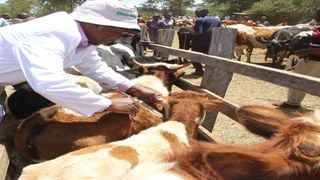
Livestock insurance helps to minimise loss and ensure continuity of business.
| File | Nation Media GroupSeeds of Gold
Premium
Know what livestock insurance covers; what it does not
Last week, my partners and I trained some new and upcoming dairy farmers. By the way nowadays, they insist on being called dairy investors, not just farmers. An investor is someone who puts efforts and resources into a venture for tangible benefits. She will close the venture as soon as she finds out that the activity is not generating the desired benefit.
Farmers, on the other hand, may keep animals for many reasons including sentimental value or social recognition. An increasing number of young and educated Kenyans are getting into livestock farming. They are investors because their ventures must be able to generate enough revenue to be self-sustaining and pay the bills.
One of the main topics of the training was livestock insurance. It raised a lot of interest particularly when the presenter informed them that there are outcomes that the insurance does not cover. They wanted to fully understand the rationale behind the denial of compensation when the end result was the loss of an insured animal.
Insurance covers all loss outcomes where the investor could not have avoided and had no way of predicting their happening. In short, insurance compensation is the act of last resort. It is aimed at helping the investor get back to the point of production where they were before the happening.
Livestock insurance, therefore, does not make money for the investor. It helps to minimise loss and ensure continuity of business.
Muchemi, the presenter of the session, informed participants that one should always avoid losing an animal or getting severe damage because in the end, there is an amount of loss that will ultimately occur.
Some of the problems covered by insurance are natural occurrences such as lightning strikes, plant poisoning for animals in open pastures, floods, diseases without cure or preventive measures and deaths of unknown causes. However, the owner must have demonstrated that all recommended measures for disease prevention and treatment were carried out timely as advised by a licensed veterinary doctor.
The issue of problems not covered by insurance was rather contentious. Muchemi explained that issues like hardware disease where animals are killed by metallic objects they swallow were not covered.
Plant poisoning for animals in zero-grazing were also exempted from cover. Death due to worm infestation and mastitis also fell in the same category. Calves are only covered from 90 days of age and cows up to eight years.
One farmer said it was unfortunate that insurance tended not to cover the most common causes of death in dairying. Further, he said the ages of animals not covered were the most vulnerable to diseases. Muchemi explained insurance covers risks that are not predictable because the investor has no way of avoiding them.
Specifically, he demonstrated why insurance does not cover hardware disease and worm infestation. Fortunately, I had pictures of a cow from Ruai that had died with involvement of the two problems. The case clarified matters for the learners.
My professional colleague, Dr Maggiey, had attended the case. The cow had been treated for pneumonia before her treatment without success. She was called because the animal had difficulties in calving. Before she could pull out the calf, the cow collapsed and died.
When she opened up the carcass for post-mortem examination, she recovered a magnet in the stomach chamber, called reticulum, with 15 nails attached to it. None of the nails had perforated the walls of the reticulum to damage other internal organs. When that happens, the animal is said to have hardware disease or traumatic reticulopericarditis or peritonitis (TRP).
Cows swallow nails and wires when they take them into the mouth in feed because they do not have the urge to spit or spitting reflex. The nails settle in the reticulum. If there is no magnet, the nails may be pushed against the stomach walls by stomach movements and they pierce through to other organs.
Maggiey was surprised why the animal had had signs of pneumonia non-responsive to antibiotic treatment; yet there was no TRP. The answer was evident when she opened the chest. It contained numerous fluid-filled sacks of various sizes. They replaced most of the lung and heart tissues making the organs poorly functional.
The disease is called hydatid cysts or hydatidosis. It is caused by the hydatid worm. The adult worm resides in dogs and sheds out eggs through faeces. When the eggs get into humans or other animals through food and water, they release a larva, which gets into the body through the intestinal blood vessels. The larva gets trapped in tissues with high blood supply mainly the lungs, heart, liver and peritoneum. They form the cysts as seen in the cow and destroy normal tissue.
The cysts grow to various sizes and can contain large amounts of clear fluid. The animal wastes away and eventually dies due to destruction of vital tissues and organs or rapture of the cyst.
Muchemi explained that the farmer in the Ruai case had protected his animal from TRP with the magnet. Hence TRP is preventable and insurance would not compensate a TRP death. On the other hand, cattle are supposed to be treated for worms every three months with suitable medicine. The Ruai farmer would not have got hydatidosis if he had been appropriately treating his cow.





